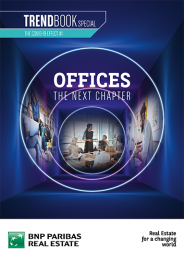The notion of the individual workspace was already on the out, with a preference for use rather than ownership. On a day-to-day basis we spend a lot of time in meetings or at appointments, the occupation rate of a whole building is 30% if we include evenings, nights, weekends, holidays and bank holidays.The office is an under-used space, it’s a fact. If we combine this with the scarcity of property and the fact that resources and energy are finite, each existing square metre must be used better and be better connected to transport, that’s why there is a need to have centralised facilities. This will be the role of tomorrow’s headquarters.
Moving towards new “productive ecosystems”
We are moving towards an even more obvious hybridisation; with the confirmed success of remote working, an appreciation for intermediaries such as third places (co-working spaces etc.) and an essentialisation of the headquarters, the real mother ship of a company’s organisation. This flagship aspect can be conveyed through its aesthetics, a distinct and unique design capable of transmitting a true identity through the buildings’ curves and shapes. Métal 57, the new headquarters of BNP Paribas Real Estate meets these criteria in practical terms. Making way for multi-functional spaces, which are more accessible to the city, while also allowing for the modularity of the building, this project, clearly illustrates these concepts. This means letting different spaces interact together, optimising them and lending them out to other activities if needed. In a practical way, the building would be shared with other companies, be transformed into a co-working space, and be used during the evening and on weekends. Métal 57 will have longer opening hours and the use of the space will be more intense. It’s a practical and pragmatic example of a flexible, central and shared office, allowing for adjustment factors in order to best optimise the occupation rates.
Next, for each player there is of course a need to define, depending on their activity and their requirements, what being central means for them and what “the best place” would be for them to settle. Central doesn’t necessarily mean the centre of big cities, even if I’m sure that they will remain very attractive in the long-term. Cities like London and Paris offer the infrastructure and service mobility necessary in order to connect employees and clients at the headquarters. The idea is not to stop going to work in one place, because as was proved by the massive “remote working” experiment, we can very easily do that from home, but rather optimise the headquarter’s space, creating the perfect location for interaction and opportunities.
The health crisis has allowed us to gather insight into how beneficial the “home office” is, because it erased commuting time, allowed for a certain comfort and form of independence, but also showed how much the office building is appreciated. In my view, I find that this isn’t a contradictory sentiment, indeed it’s the opposite, this proves that a company is neither more nor less the sum of the individuals who make it up and create value together and the headquarters is what brings them all together.
When I’m asked what the future office will look like, I answer that it’s not an office. It is more what I call a productive ecosystem. Which is comprised of the home office, the headquarters and third places. The proportion of each will depend on the company, its requirements, its culture, and its management model.


The health crisis calls into question the myth of the megalopolis and its population density. After three months of lockdown, maybe some people will be more enticed by greenery and will see the city differently. I’m not saying that the city will lose its draw, on the contrary, but if living spaces move out to locations which allow for self-development, while also staying connected to the epicentres of economic activity, we could see a different kind of population distribution.
Third places, hybridisation and space modularisation
The health crisis calls into question the myth of the megalopolis and its population density. After three months of lockdown, maybe some people will be more enticed by greenery and will see the city differently. I’m not saying that the city will lose its draw, on the contrary, but if living spaces move out to locations which allow for self-development, while also staying connected to the epicentres of economic activity, we could see a different kind of population distribution.
Today, it’s impossible to predict what’s going to happen, but if this trend is here to stay, third places will have a large role to play in it. It’s time to start reviving certain areas: it is easy to imagine a co-working space where a post office once stood, or in a small bank that was expected to disappear in a rural area. There is perhaps a place for those who wish to create “third places hubs” out of the cities, with better quality service offers than what working from home can provide (better internet connection, access to shared resources, and the possibility of socialising). The co-working sector players have already invested in locations out of the big cities and this was even before the health crisis, it is therefore not impossible to see this trend continuing in order to respond to employees’ ambitions. In the smaller cities and on the initiative of city councils, we have also seen mixed spaces popping up over the last few years, managed by City Centre Managers. Lockdown has created new demands, over time it will be interesting to see if this will continue or if the old habits will return.
In any case, I think that the functional city is no more. Spaces uniquely dedicated to a very specific activity (home/work/consumption) are a thing of the past and practically all new urban projects aspire to blend functionalities. The price per square metre is such that in certain cities we don’t have the luxury of leaving spaces empty during off-peak periods or at certain times. Financially, but also from an ecological standpoint, this is becoming almost unthinkable.
I think that we are entering into a structural economic crisis and that the impact of this pandemic will be felt for the next five years. Real estate is the second highest company expenditure, it is therefore imperative to optimise space as much as possible. Remote working goes some way towards responding to this budgetary optimisation, it leads the way for a better balance between work and home life and minimises the inherent costs of working from an assigned space. It is therefore likely that the average surface area per square metre is going to stabilise, just as we have seen in the past. The need for a central headquarters will mean that the market will remain just as competitive, even more so for the simple reason that the need for a central location remains the overriding factor in the choice of premises.
“Reversible building use as a value provider”
It’s how we use the building which creates value and these functions evolve cyclically. The office building must be as reversible as possible. There will also be a market for pre-owned properties. We can easily imagine the existing skyscrapers at La Défense becoming housing or co-living spaces. A typical Haussmann style building in Paris, as we have seen, can adapt to these evolutions: as offices, housing, or shopping centres. In a world of finite resources, it is crucial to preserve biodiversity and I think that the future of construction will be found in part in renovation.
In order to do this, it is essential to be able to measure and eventually, make profits. This is where technology comes in, in this process of rationalisation. By knowing when and how spaces are used, we can adjust so that they can be used optimally. This can and will apply to all buildings as has already been done for energy consumption. Today, working with start-ups, BNP Paribas Real Estate is developing this type of tool which will better enhance the building and will let occupiers adapt, vacate, or grow as the circumstances dictate. Innovation also happens through space modularity when “real estate” becomes “furniture”. Why couldn’t three individual offices become a meeting room for half an hour? The possibilities are endless and especially, in the long-term, it will cost less for the company because the building structure will become less of a constraint and more a way of leveraging the lay out.

TrendBook Offices: the next chapter
What is life in our offices going to look like post Covid?
Take a deeper look at the trends, innovations and new ways of interacting with space that are going to affect our professional spaces.




